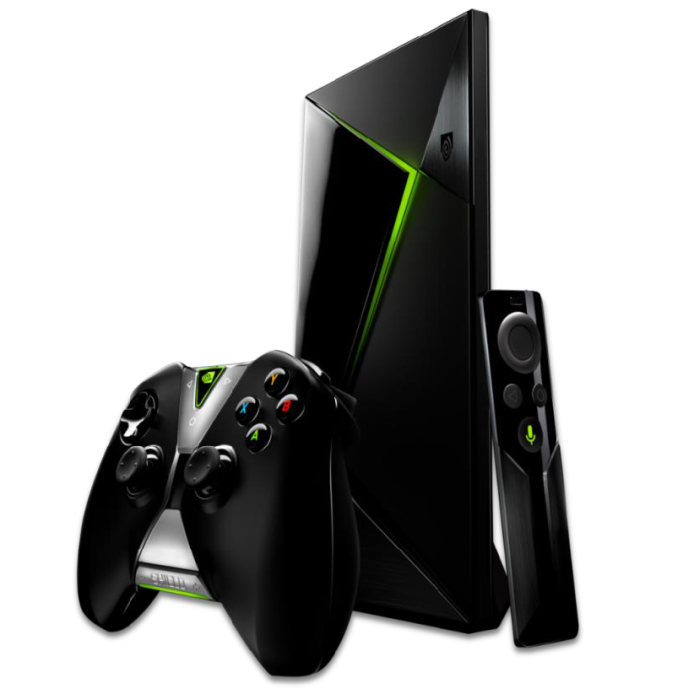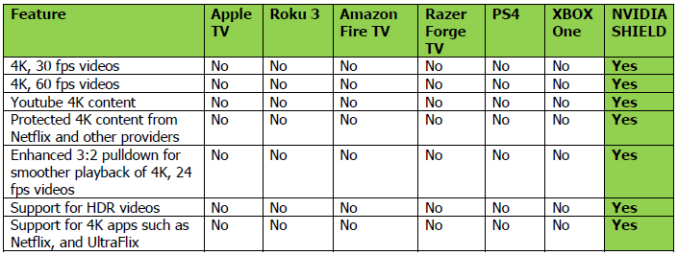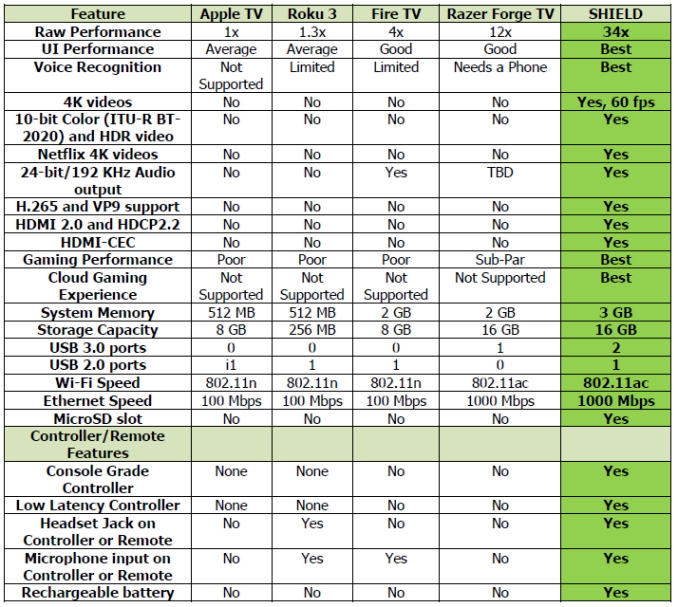The NVIDIA SHIELD Android TV Review: A Premium 4K Set Top Box
by Ganesh T S on May 28, 2015 3:00 PM EST- Posted in
- Media Streamer
- Home Theater
- TV
- 4K
- Shield
- NVIDIA

The battle for the living room (i.e, controlling the television experience) is heating up with forays from multiple vendors. As the cord-cutting trend gains momentum, the time seems to be right for disruption. Roku has been around for a long time and they continue to taste success with inexpensive and small over-the-top set-top boxes (OTT STBs). At the other end of the spectrum is the Apple TV, which, despite just being a 'hobby', has managed to move millions of units. Google had tried to make inroads into this market a few years back with the Google TV / Logitech Revue, but, it unfortunately didn't pan out as expected. Chromecast turned out to be more popular in their second attempt, but it was a limited play. In late 2014, Google launched Android TV along with the Nexus Player.
Coinciding with Google I/O, NVIDIA is releasing their previously announced SHIELD Android TV. First announed back in March at the 2015 Game Developers Conference, SHIELD Android TV is a premium 4K-capable over-the-top set-top box (OTT STB) with a powerful graphics engine. The differentiating aspects compared to the Intel Bay Trail-based Nexus Player and the Qualcomm Snapdragon-based Razer Forge TV lie in 4K support (HDMI 2.0 / HDCP 2.2 / Netflix 4K-certification) and excellent gaming credentials.
| NVIDIA SHIELD Family | ||
| NVIDIA SHIELD Tablet | NVIDIA SHIELD Android TV | |
| SoC | Tegra K1 (2.2 GHz 4x Cortex A15r3, Kepler 1 SMX GPU) | Tegra X1 (4x Cortex A57 + 4x Cortex A53, Maxwell 2 SMM GPU) |
| RAM | 2 GB LPDDR3-1866 | 3 GB LPDDR4-3200 |
| NAND | 16/32GB NAND + microSD | 16GB NAND + microSD + USB |
| Display | 8” 1920x1200 IPS LCD | N/A, HDMI 2.0 4Kp60 Output |
| Dimensions | 221 x 126 x 9.2mm, 390 grams | 210 x 130 x 25mm, 654 grams |
| Camera | 5MP rear camera, 1.4 µm pixels, 1/4" CMOS size. 5MP FFC | N/A |
| Battery | 5197 mAh, 3.8V chemistry (19.75 Whr) | N/A, 40W Power Adapter |
| OS | Android 5.0.1 | Android TV |
| Connectivity | 2x2 802.11a/b/g/n + BT 4.0, USB2.0, GPS/GLONASS, mini HDMI 1.4a | 2x2 802.11a/b/g/n/ac + BT 4.1/BLE, USB 3.0 + 2.0, HDMI 2.0 + HDCP 2.2, IR Receiver, Gigabit Ethernet |
| Launch Price | $299 (16GB/WiFi) + $59 (optional controller) | Basic: $199, Includes 1 SHIELD Controller Pro: $299, Adds 500GB Hard Drive |
The NVIDIA SHIELD smart TV platform comprises of three distinct products, the SHIELD console, the SHIELD wireless controller and the SHIELD remote.
The SHIELD is the main console, integrating a Tegra X1 SoC along with 3 GB of LPDDR4 DRAM and 16 GB of storage. I/O ports include two full-sized USB 3.0 host ports, a USB 2.0 micro-USB device port, GbE RJ-45 port, IR for universal remotes and 802.11ac 2x2 MIMO Wi-Fi with Bluetooth 2.1. It also includes a microSDXC slot. Video output is handled by a HDMI 2.0 port with HDCP 2.2 support.
The SHIELD Wireless Controller is the game controller bundled with the SHIELD console, and was first launched last year with the SHIELD Tablet. It uses Wi-Fi Direct for communication. A stereo headset jack and microphone are integrated. It also includes a rechargeable battery that can provide up to 40 hours of battery life.
Finally, the SHIELD Remote It is meant to be a replacement for the game controller in situations where single-handed operation is preferable. It uses Bluetooth for communication with the console. Like the game controller, a microphone and headset jack are included. The rechargeable battery is good for up to 4 weeks.
While the game controller and the console together retail in the basic package for $199, the SHIELD Remote is available separately for $50. Meanwhile after a slight snafu where it was announced back in April and then immediately pulled, NVIDIA is indeed offering a higher-end Pro SKU. SHIELD Pro model is similar to the SHIELD described above, except it adds an internal 500 GB hard drive into the mix and bundles a game - Borderlands: The Pre-Sequel! The Pro model is priced at $299.
Prior to diving into the details, let us take a look at the devices that NVIDIA is positioning the SHIELD Android TV against. Note that the two tables below are direct from NVIDIA's marketing material.
As we will see further down in the review, the above table is not far from the truth. In fact, except for NVIDIA claiming that their pulldown algorithm is enhanced compared to the competition, we tend to agree with everything. For the moment at least, NVIDIA pretty much has the 4K set top box to themselves.
NVIDIA claims a 34x raw performance increase compared to other OTT STB platforms. We won't endorse that particular number, but, in general, the performance of the SHIELD is miles ahead of the competition. The only other entry we find contentious is the availability of 24-bit / 192 KHz audio output. As we will see in the local media playback evaluation section, this is something of a moot point in most scenarios since the unit doesn't have licenses for decoding lossless HD audio. In any case, the above tables give an idea of where NVIDIA is positioning the SHIELD Android TV in the market.
The NVIDIA SHIELD Android TV also happens to be the first shipping product with the Tegra X1 SoC. We will first analyze the SoC and its performance in detail before moving on to Android TV in general and the SHIELD in particular.













167 Comments
View All Comments
ganeshts - Saturday, May 30, 2015 - link
It plays perfectly! As in, the audio seems to start a bit before the video starts, but when the pianist and the accompanying people start to speak, the audio and video are in sync.This was with the native Android Video Player
frankiepoon - Saturday, May 30, 2015 - link
Thx a lot, I will buy one then!OrphanageExplosion - Friday, May 29, 2015 - link
Android gaming just doesn't really work. The frame-pacing on every non-60fps title I've played is all over the place. So much judder :/AgeOfPanic - Friday, May 29, 2015 - link
Just wanted to complement you on the review. Somehow this site almost always manages to answer all the questions I have about a product I'm interested in. For me the current lack of refresh rate switching and bitstreaming of HD audio means that I'll pass for now, but I will follow the developments. I'm a little pessimistic, because the focus here is on streaming video and not HTPC use and there the lack of these features is less of a deal breaker.ruthan - Friday, May 29, 2015 - link
Yes, there is few design flaws and price for 500 GB model is too high, but it looks like best android gaming console without real competitor.fteoath64 - Tuesday, June 2, 2015 - link
Get the 16GB model and stick your own USB disk into it!. Solved.robertjan88 - Friday, May 29, 2015 - link
So, just to double check, file types like MKV, MP4 etc are fully supported for playback from an external HDD or SD-card? And x264 MKV?They're only listing H264 and 265, but no clue what the types are. :(
And what about the audio? Normal stereo, 5.1 and PCM are supported?
Many thanks for the feedback!
jwcalla - Friday, May 29, 2015 - link
As far as I know, container types have never been restricted on Android. It usually comes down to whether the software (app) supports them.BrokenCrayons - Friday, May 29, 2015 - link
Is there really that much of a market for non-mobile devices like this? I admit I don't know much about Android TV, but I guess if it supports a wireless keyboard and touchpad as well as letting you download an office suite it'd be somewhat flexible, but you still can't easily pick it up and take it with you to your couch or go to a coffee shop and use it to write while you're getting away from your apartment so it strikes me as extremely redundant with a tablet and even less useful in light of the fact that x86 Windows operating systems are now available on a tablet for lower cost than this screenless and batteryless device. Sure it's faster, but most of that performance is invested in graphical capabilities that aren't very important when you're playing a quick YouTube video, sending an e-mail, or writing something in a word processor. Plus, you have to also buy a screen for it which drives up the purchase price significantly since even a 15 inch screen would add another $100 or more.jwcalla - Friday, May 29, 2015 - link
You use a tablet as an HTPC?I don't think this device is intended for sending e-mails or writing documents.